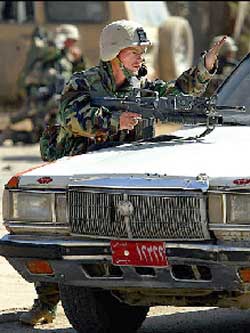Brooks showed video of U.S. troops carrying wounded Pfc. Jessica Lynch on a stretcher from a helicopter to a plane after she was rescued in a daring raid at a hospital in the south-central Iraqi town of Nasiriyah. She had been held as a prisoner of war since her unit was attacked by Iraqis on March 23. The grainy, green-tinted video taken with night-vision lenses showed her to be alert as she lay on the stretcher. A still photograph of her showed a folded American flag resting on her as she smiled and looked at the camera. "Some brave souls put their lives on the line to carry this out," Brooks said. Brooks said that 11 bodies were recovered in the nighttime raid. Two were found in the morgue of the hospital and a captured Iraqi led U.S. troops to the bodies of nine other people who were buried in the town outside the hospital, he said. U.S. forensics experts were trying to identify the remains. The rescue force fought its way into and out of the hospital with Iraqis firing on them from nearby buildings, he said. She was held by paramilitary troops who dress in civilian clothes. Troops found munitions, mortars, maps and a terrain model in the hospital, indicating it was used as a military command center. Participating in the raid were Army Rangers, Navy SEALS, Air Force pilots and U.S. Marines, he said. In Najaf, about 50 miles south of Karbala, the Central Command said U.S. forces were being fired on from the Ali Mosque, one of the most important Shiite Muslim sites. U.S. commanders are trying to prevent damage to religious sites to avoid angering Muslims in Iraq and abroad. He said coalition forces "were disciplined ... and chose not to return fire against this mosque to keep it protected." Brooks described the takeover of the mosque by Iraqi troops as "a detestable example of putting historical sites in danger." Video was shown of Iraqi troops positioning two tanks on transporters next to another mosque. Brooks said a third truck carried a container that exploded, but that there were no U.S. warplanes or other weapons in the area that could have caused the blast.
|
